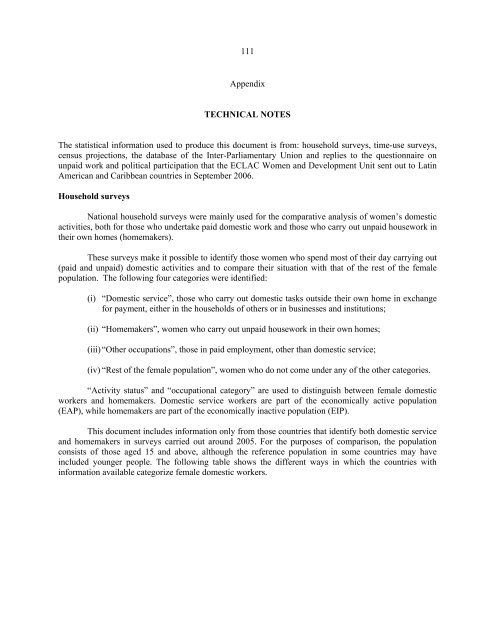Women in Latin America and the Caribbean - Cepal
Women in Latin America and the Caribbean - Cepal
Women in Latin America and the Caribbean - Cepal
You also want an ePaper? Increase the reach of your titles
YUMPU automatically turns print PDFs into web optimized ePapers that Google loves.
111<br />
Appendix<br />
TECHNICAL NOTES<br />
The statistical <strong>in</strong>formation used to produce this document is from: household surveys, time-use surveys,<br />
census projections, <strong>the</strong> database of <strong>the</strong> Inter-Parliamentary Union <strong>and</strong> replies to <strong>the</strong> questionnaire on<br />
unpaid work <strong>and</strong> political participation that <strong>the</strong> ECLAC <strong>Women</strong> <strong>and</strong> Development Unit sent out to Lat<strong>in</strong><br />
<strong>America</strong>n <strong>and</strong> <strong>Caribbean</strong> countries <strong>in</strong> September 2006.<br />
Household surveys<br />
National household surveys were ma<strong>in</strong>ly used for <strong>the</strong> comparative analysis of women’s domestic<br />
activities, both for those who undertake paid domestic work <strong>and</strong> those who carry out unpaid housework <strong>in</strong><br />
<strong>the</strong>ir own homes (homemakers).<br />
These surveys make it possible to identify those women who spend most of <strong>the</strong>ir day carry<strong>in</strong>g out<br />
(paid <strong>and</strong> unpaid) domestic activities <strong>and</strong> to compare <strong>the</strong>ir situation with that of <strong>the</strong> rest of <strong>the</strong> female<br />
population. The follow<strong>in</strong>g four categories were identified:<br />
(i) “Domestic service”, those who carry out domestic tasks outside <strong>the</strong>ir own home <strong>in</strong> exchange<br />
for payment, ei<strong>the</strong>r <strong>in</strong> <strong>the</strong> households of o<strong>the</strong>rs or <strong>in</strong> bus<strong>in</strong>esses <strong>and</strong> <strong>in</strong>stitutions;<br />
(ii) “Homemakers”, women who carry out unpaid housework <strong>in</strong> <strong>the</strong>ir own homes;<br />
(iii) “O<strong>the</strong>r occupations”, those <strong>in</strong> paid employment, o<strong>the</strong>r than domestic service;<br />
(iv) “Rest of <strong>the</strong> female population”, women who do not come under any of <strong>the</strong> o<strong>the</strong>r categories.<br />
“Activity status” <strong>and</strong> “occupational category” are used to dist<strong>in</strong>guish between female domestic<br />
workers <strong>and</strong> homemakers. Domestic service workers are part of <strong>the</strong> economically active population<br />
(EAP), while homemakers are part of <strong>the</strong> economically <strong>in</strong>active population (EIP).<br />
This document <strong>in</strong>cludes <strong>in</strong>formation only from those countries that identify both domestic service<br />
<strong>and</strong> homemakers <strong>in</strong> surveys carried out around 2005. For <strong>the</strong> purposes of comparison, <strong>the</strong> population<br />
consists of those aged 15 <strong>and</strong> above, although <strong>the</strong> reference population <strong>in</strong> some countries may have<br />
<strong>in</strong>cluded younger people. The follow<strong>in</strong>g table shows <strong>the</strong> different ways <strong>in</strong> which <strong>the</strong> countries with<br />
<strong>in</strong>formation available categorize female domestic workers.











